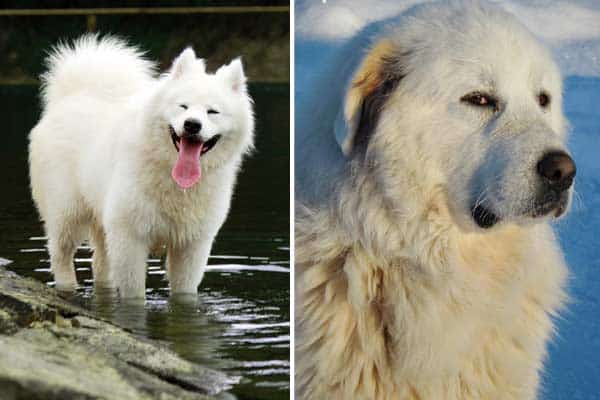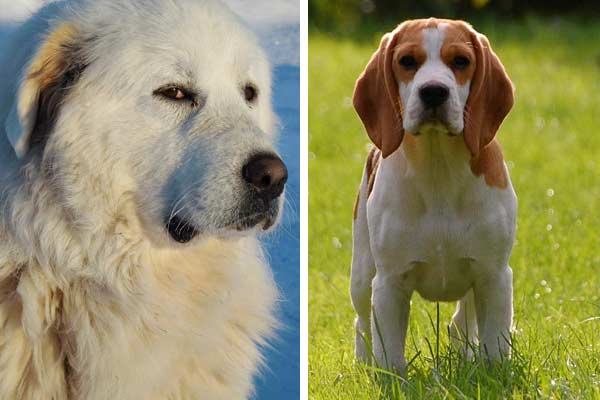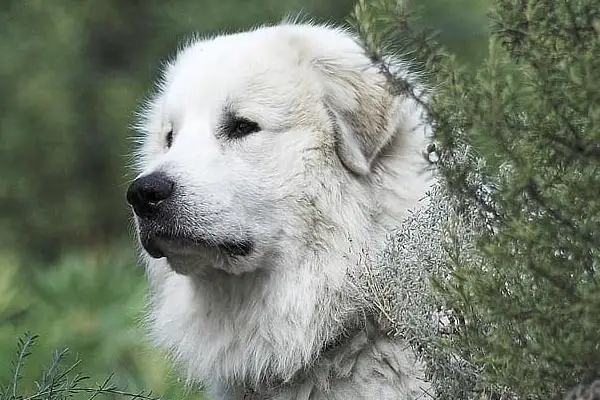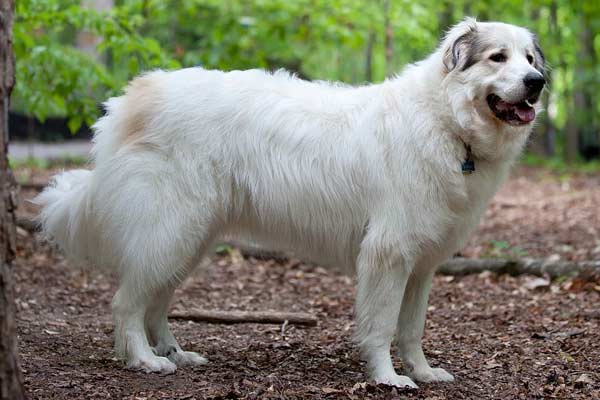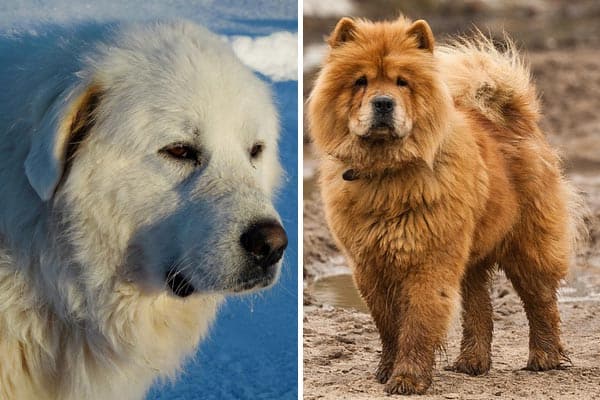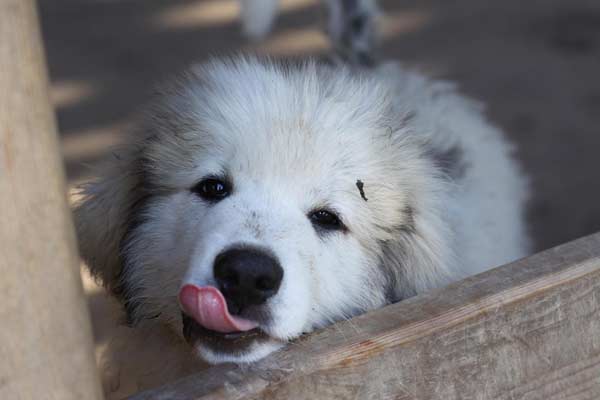When Do Great Pyrenees Stop Growing: What to Expect With This Slow Growing Dog Breed
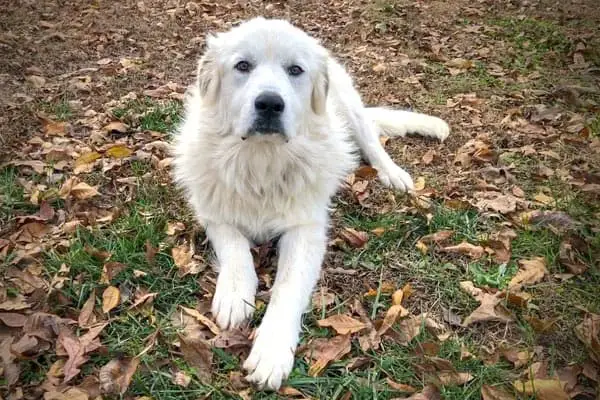
The Great Pyrenees dog is one of the 15 largest American Kennel Club (AKC) registered dog breeds. These dogs start out like all puppies do – small and cute.
But then they start to grow and grow and grow. These dogs have a lot of growing to do! And it is important that they don’t grow too quickly, as we will discuss later on here in this article.
If you are considering adding a Great Pyrenees dog to your family, you already know you are ultimately choosing a very, very large dog. But it can be hard to visualize that when you are staring at a cuddly little fluffy puppy.
So let’s take a much closer look at the Great Pyrenees growth cycle so you know what to expect and how to plan for your puppy’s growth.
When Does Great Pyrenees Stop Growing?
There is a general rule of thumb in canine circles: the larger the dog, the slower the growing up period.
A giant breed puppy like the Great Pyrenees can take up to 18 months to finish growing. However, some experts explain that even after 18 months, there may be an additional period of up to four years when the Great Pyrenees may continue to fill out. So this means you can expect your Great Pyrenees to be about as tall as they will get by 18 months old and as heavy as they will get by four years old (or sooner).
Watch a Great Pyrenees Puppy Growing Up
This sweet video shows the progression of the Great Pyrenees growing up from three weeks to four months old.
This video shows you what happens after four months all the way up to when the Great Pyrenees is fully grown.
It can feel absolutely mind-blowing to try to imagine such a tiny puppy growing up into a potentially 100-pound adult dog. While it happens slower with the Great Pyrenees, it definitely will happen – make no mistake about it.
Why Do the Great Pyrenees Take So Long to Reach Adulthood?
As VCA Animal Hospitals point out, it is very important not to try to rush the process of a large or giant breed puppy (or any puppy) growing up.
There are several reasons for this cautionary guidance.
Skeletal structure
The first and most compelling reason that the Great Pyrenees needs to grow slowly into their full adult size is that growing too quickly can cause skeletal malformation.
The entire skeletal structure is a complicated support system consisting of bones, muscles, tendons, ligaments, nerves, blood vessels, and tissues.
All of these parts of the whole are growing at the same time and some may grow faster than others. By keeping the overall growth rate measured, this allows for the entire structure to grow in sync into adulthood.
Bone density
When you look at a tiny toy breed dog like a Chihuahua, it is clear the bones don’t have a lot of growing to do before they get to full size.
But a Great Pyrenees can easily stand nearly three feet tall according to the American Kennel Club (AKC) breed standard.
So those are going to be some pretty big bones! The bones in the legs are the longest bones in the body and if they grow too fast, they won’t absorb sufficient calcium to become dense and strong to support the dog properly.
Joint formation
In the same way that the skeletal system and the bones are growing larger and denser and getting heavier, the joints are also trying their best to form properly and grow larger.
At the same time, all that mass of bone, muscle, and tissue is getting heavier and heavier and putting more pressure on the joints.
If too much pressure is placed on the developing joints too early in the dog’s development, the joints may not form properly.
Weight management
While it may not look like much is happening on the outside, on the inside, a giant breed puppy like the Great Pyrenees is going to be burning up a lot of energy every day just growing up.
It is vitally important to feed your dog a proper giant dog breed puppy diet so your Great Pyrenees takes in the right daily blend of nutrients, protein, fat, and carbohydrates to feed their growing body without packing on extra pounds.
When a Great Pyrenees puppy is not fed a proper puppy diet, there is a risk of dietary imbalance that can lead to nutritional deficiency.
At the same time, if a giant breed puppy gains too much weight (fat), this can put tremendous pressure on the still-developing systems in the body can cause malformation and a lifetime of health problems.
Great Pyrenees Health Issues That Are Caused By Too-Fast Puppy Growth
There are a number of serious lifelong health issues that can arise when a giant breed puppy like the Great Pyrenees experiences too fast growth during any part of the growing up period.
This period typically is regarded to be birth to 18 months, although as you now know, some growing may continue to occur all the way up to the age of four years old.
So let’s take a closer look now at the major health issues that are known to occur when a Great Pyrenees puppy grows up too fast.
Osteochondrosis
As DVM360 explains, osteochondrosis is one of a number of developmental orthopedic conditions that can occur when a large or giant breed puppy grows up too fast.
Osteochondrosis is sometimes also called osteochondritis dissecans or simply OCD. It can cause deformities in the bone or cartilage that results in malformed bones and limbs in adulthood.
Acute inflammatory joint disease
The acute inflammatory joint disease often co-occurs with osteochondrosis.
When the cartilage in a growing bone gets exposed to the synovial fluid (joint fluid), this can cause severe inflammation and pain.
This can set up a lifelong cycle of degenerative joint disease. It often begins very early in life within the first 12 months of a puppy’s growth cycle.
Hypertrophic osteodystrophy (HOD)
Each long leg bone has a growth plate. This growth plate is the “control center” so to speak that tells the bone to grow or to stop growing.
When the growth plate itself gets inflamed, this is called hypertrophic osteodystrophy.
The inflammation is quite painful while it lasts, which for some dogs is a short time only and for other dogs may be a long time. While it tends to resolve on its own, it may leave behind a lasting legacy of bone and cartilage deformity.
Dysplasia of the hip, elbow or shoulder
Dysplasia of the hip, elbow, or shoulder is best known as a genetic (hereditary) condition that is more prevalent in some dog breeds than others.
Genetically speaking, it is also a condition that occurs more commonly in large and giant breed dogs than in smaller dog breeds.
However, dysplasia, which basically refers to a malformation of the ball and socket mechanism that causes joints to move, can happen as a result of too-fast puppy growth as well.
When dysplasia in any affected joint occurs, it may range from mild to severe. Mild cases can often be treated with physical therapy and medication. There is no treatment for severe dysplasia other than a full surgical replacement of the defective joint.
Luxating patella (patellar luxation)
Luxating patella is sometimes called “trick knee” because it basically causes the knee joint to slip out of the socket.
While patellar luxation is far more common in small dog breeds, it can occur in any dog where the puppyhood growth is too rapid for the breed’s overall adult health.
Mild cases of luxating patella are often treatable with physical therapy and medication. Severe cases also require surgical intervention.
Panosteitis (“growing pains”)
Panosteitis is often nicknamed growing pains because it tends to occur during puppyhood, often arising and subsiding several times during the intense growth period and then resolving on its own in later puppyhood or adulthood.
Sometimes panosteitis is also nicknamed “shifting leg lameness” because it can affect one limb and then another as the dog grows. The only treatment is pain medication and time.
How to Manage Your Great Pyrenees Puppy’s Growth Safely
There is no substitute for keeping in close contact with your canine veterinarian while your Great Pyrenees puppy is growing up.
You want to be sure you are feeding an appropriate giant breed puppy food that offers complete and balanced daily nutrition for a growing giant breed puppy like the Great Pyrenees.
As Up North Pyrenees breeder explains, choosing the right puppy food is a critical part of ensuring your adult dog is healthy and strong.
It is common to feed young puppies (less than six months old) three times per day. At around six months, many puppy owners will transition to feeding twice per day. By 12 months of age, most puppies are eating once per day.
As the Great Pyrenees Club of America (GPCA) points out, your puppy should always have plenty of freshwaters to drink as well.
Feeding your Great Pyrenees puppy at scheduled times each day and feeding the same puppy food each day will help with the growth and development of the digestive and elimination (bladder and bowel) system. This in turn will help with house training.
As the GPCA explains, the Great Pyrenees may be a strong and sturdy giant dog breed, but they don’t have a very high metabolism in general.
However, your Great Pyr puppy may try to beg for more food or treats as they get more comfortable with you. Don’t add treats, supplements, or additional vitamins and minerals to your puppy’s diet unless your canine veterinarian specifically advises this.
It is actually much better to feed a little less of a high-quality commercial or prepared puppy food suitable for giant breed puppies than to feed a larger quantity of generic puppy food.
Puppy food that is formulated for “all dogs” or for small to medium breed puppies will not meet your Great Pyrenees puppy’s nutrient needs in full and can lead to ongoing health issues.
How to Know Your Great Pyrenees Puppy Is Finished Growing Up
Remember those growth plates in the bones that we discussed in an earlier section here?
The growth plates are your number one indicator that your Great Pyrenees puppy has finished growing up.
As long as your Great Pyrenees puppy has more growing left to do, the growth plates in the bones will stay soft and “open.” This means they are vulnerable to injury, which is why it is so vital not to over-exercise your dog until they have closed.
As Ready to Go Veterinary Rehabilitation clinic points out, the only way to know for sure if a puppy’s growth plates have closed is to have them X-rayed.
Most dog owners have this done around the age of 12 months. But because you know that a giant dog breed like the Great Pyrenees typically continues growing up until at least 18 months of age, you may want to wait for the X-rays until your dog is 18 months old.
Without having the X-rays done, you really don’t have any verifiable method of knowing when your Great Pyrenees puppy is done with their growing.
This does not mean your puppy will not continue to “fill out” and increase in weight after the growth plates have closed.
But it does mean that the risk period for the joint, skeletal and bone health problems you read about earlier here is largely over.
By understanding the unique growth process for a giant dog breed puppy, you can do all the right things to help your Great Pyrenees grow up healthy and strong.
